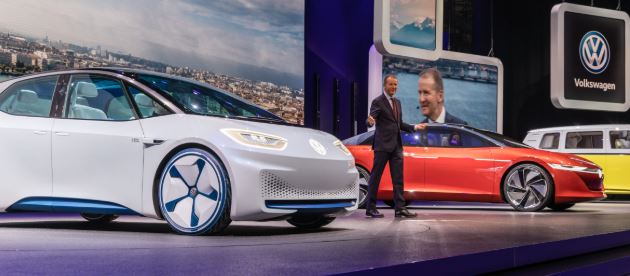
“Electric vehicles have come a long way in recent years, and the future of mobility is poised to take an exciting turn in 2025. As advancements in battery technology, charging efficiency, and autonomous driving features continue to shape the industry, the most anticipated electric vehicles are set to redefine the way we think about transportation.
| Key Feature | Anticipated Improvement |
|---|---|
| Battery Range | Increased to over 400 miles on a single charge |
| Charging Time | Reduced to under 30 minutes for an 80% charge |
| Autonomous Driving | Level 4 or 5 capabilities for hands-free operation |
These advancements, coupled with a growing focus on sustainability and environmental impact, are driving the rapid adoption of electric vehicles across the globe. As the market continues to evolve, consumers can expect to see a wider range of affordable and accessible options, as well as seamless integration with smart city infrastructure.
What are Electric Vehicles?
Electric vehicles, or EVs, are automobiles that are powered by one or more electric motors, rather than traditional internal combustion engines. Unlike their gasoline-powered counterparts, electric vehicles rely on rechargeable battery packs to store the energy needed to power the vehicle’s drivetrain. This shift in technology has profound implications for the future of transportation, as it offers a more sustainable and environmentally-friendly alternative to traditional fossil fuel-powered vehicles.
Advancements in Battery Technology
One of the most significant advancements driving the growth of electric vehicles is the rapid progress in battery technology. Researchers and engineers have been working tirelessly to develop more efficient, longer-lasting, and more affordable battery packs that can power electric vehicles over longer distances. The introduction of lithium-ion and lithium-polymer batteries, for example, has greatly improved the energy density and power output of EV battery systems, allowing for increased range and faster charging times.
Increased Range and Charging Efficiency
As battery technology continues to evolve, electric vehicles are becoming increasingly capable of traveling longer distances on a single charge. The latest models are boasting ranges of over 400 miles, a significant improvement from the earlier generations of EVs that struggled to reach 200 miles. Additionally, the development of faster charging systems has reduced the time required to replenish the battery, with some models now able to reach an 80% charge in under 30 minutes. These advancements are crucial in addressing the “”range anxiety”” that has historically been a barrier to widespread EV adoption.
Sustainability and Environmental Impact
The shift towards electric vehicles is not just about technological advancement; it’s also about creating a more sustainable and environmentally-friendly future. By eliminating the need for gasoline or diesel, electric vehicles significantly reduce greenhouse gas emissions and air pollution, making them a crucial component in the fight against climate change. As the world becomes more conscious of the environmental impact of transportation, the demand for clean, efficient electric vehicles is only expected to grow.
Autonomous Driving Features
The future of electric vehicles is not just about the powertrain; it’s also about the integration of advanced autonomous driving technologies. Many of the most anticipated EV models in 2025 will feature Level 4 or even Level 5 autonomous capabilities, allowing for hands-free operation in a wide range of driving scenarios. These self-driving features, combined with the inherent efficiency of electric motors, have the potential to revolutionize the way we think about transportation, making it safer, more convenient, and more accessible to a wider range of people.
Affordability and Accessibility
One of the key challenges that has historically hindered the widespread adoption of electric vehicles is the higher upfront cost compared to traditional gasoline-powered cars. However, as battery prices continue to decline and economies of scale take effect, electric vehicles are becoming increasingly affordable and accessible to a broader range of consumers. Governments around the world are also offering various incentives and subsidies to encourage the adoption of EVs, further improving their affordability and making them a more viable option for a larger segment of the population.
Integrating EVs with Smart City Infrastructure
As electric vehicles become more prevalent, the need for a robust and integrated infrastructure to support their operation is becoming increasingly important. Smart city initiatives are paving the way for the seamless integration of EVs with features like wireless charging stations, dynamic traffic management systems, and intelligent energy grids. This integration will not only make it easier for EV owners to charge and navigate their vehicles but also contribute to the overall efficiency and sustainability of urban transportation networks.
The Shift Towards Electric Commercial Vehicles
The benefits of electric vehicles extend beyond the personal transportation market. The commercial sector is also undergoing a significant shift towards electric-powered trucks, vans, and delivery vehicles. Logistics companies and fleet operators are recognizing the advantages of reduced operating costs, lower emissions, and improved sustainability that electric commercial vehicles offer. As the technology continues to advance, we can expect to see an increasing number of electric delivery trucks, garbage trucks, and other commercial vehicles on the roads in the coming years.
Performance and Driving Dynamics
One of the surprising aspects of electric vehicles is their impressive performance and driving dynamics. Thanks to the instant torque provided by electric motors, many EV models are capable of accelerating faster than their gasoline-powered counterparts. Additionally, the low center of gravity and precise control of the electric drivetrain contribute to a more responsive and engaging driving experience. As the technology continues to evolve, we can expect to see even more powerful and dynamic electric vehicles that challenge the traditional notions of what a high-performance car can be.
Overcoming Charging Challenges
While the advancements in battery technology and charging efficiency have been significant, there are still some challenges that need to be addressed to ensure the widespread adoption of electric vehicles. The availability and accessibility of charging infrastructure, particularly in urban areas and along major transportation corridors, remain a concern for many potential EV owners. Governments and private companies are working to address this issue by investing in the expansion of public charging networks and incentivizing the installation of home and workplace charging stations.
Government Incentives and Policies
Governments around the world have recognized the importance of promoting the adoption of electric vehicles as a means of addressing environmental concerns and reducing dependence on fossil fuels. As a result, many countries and local jurisdictions have implemented a range of incentives and policies to encourage the transition to EVs. These include tax credits, rebates, and other financial incentives, as well as regulations and mandates that support the development of charging infrastructure and the phasing out of internal combustion engine vehicles.
The Future of Mobility: Electric Vehicles in 2025
As we look towards the future, the landscape of transportation is poised to undergo a profound transformation, with electric vehicles at the forefront of this change. The most anticipated electric vehicles in 2025 will not only offer improved performance, range, and charging efficiency but will also seamlessly integrate with smart city infrastructure and autonomous driving technologies. This convergence of advancements will reshape the way we think about personal and commercial mobility, making it more sustainable, accessible, and efficient than ever before. The future of transportation is electric, and the journey is just beginning.
Conclusion
The electric vehicle revolution is well underway, and the most anticipated models of 2025 are set to redefine the future of mobility. From advancements in battery technology and charging efficiency to the integration of autonomous driving features and smart city infrastructure, the electric vehicle landscape is poised for a transformative shift. As governments, automakers, and consumers alike embrace the benefits of clean, sustainable transportation, the electric vehicle market is primed for rapid growth and widespread adoption in the years to come.
Frequently Asked Questions
What are the key features of the most anticipated electric vehicles in 2025?
The most anticipated electric vehicles in 2025 will boast a range of over 400 miles on a single charge, the ability to charge to 80% in under 30 minutes, and advanced autonomous driving capabilities up to Level 4 or 5. These advancements, combined with improved affordability and seamless integration with smart city infrastructure, will make electric vehicles more accessible and appealing to a wider range of consumers.
How will electric vehicles impact the environment and sustainability?
The transition to electric vehicles is a crucial step in the fight against climate change and environmental degradation. By eliminating the need for gasoline or diesel, electric vehicles significantly reduce greenhouse gas emissions and air pollution, making them a more sustainable mode of transportation. As the world becomes more conscious of the environmental impact of transportation, the demand for clean, efficient electric vehicles is expected to grow rapidly in the coming years.
What are the government incentives and policies driving the adoption of electric vehicles?
Governments around the world have implemented a range of incentives and policies to encourage the adoption of electric vehicles. These include tax credits, rebates, and other financial incentives, as well as regulations and mandates that support the development of charging infrastructure and the phasing out of internal combustion engine vehicles. These initiatives are designed to make electric vehicles more affordable and accessible, ultimately driving the transition towards a more sustainable transportation future.”




